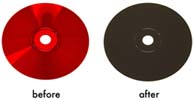A Brief History of Self-Destructing DVDs

Blockbuster Video got its start in Texas in 1985. It wasn’t the first video rental place in history but shortly, it became the largest. And as it grew, Blockbuster — and the rental biz as a whole — was putting the squeeze on Hollywood’s revenue streams. For many movie fans, it made a lot of sense to skip the theater and instead wait a few months until the movie was available for rent. Spending eight dollars a ticket to go to the movie theater adds up quickly for a family, and that’s before you even think about concessions. A Blockbuster night and a bag of microwave popcorn? It’s maybe ten dollars, all-in, and the bathrooms are probably cleaner, too. Studios had previously made up for the benefits of at-home viewing by selling movies, but the rental market put a dent in that, too. Why spend $25 to own it when you could borrow it for (way) less than a quarter of that price?
The math for the studios was easy, and it wasn’t good: for years, they were able to, basically, charge a consumer every time he or she wanted to watch a movie, or get a premium if you wanted to watch it multiple times and whenever you wished. Rentals changed the formula. Studios tried to sue Blockbuster et al out of existence but, as we know, that failed. And consumers liked the price and convenience of rentals, leaving Hollywood with a bit of a dilemma.
So they rigged their DVDs to self-destruct.
 In the early 2000s, a company called Flexplay Technologies developed a special type of DVD, one which looked like a regular disc with one major difference: the readable side was colored red. But two days after you opened the package, that would change. As Flexplay’s long-gone website explained, “the end of [that] viewing window, the Flexplay DVD [would turn] from red to black.” Per TIME, the DVDs were “made with a special glue that is sensitive to oxygen. Once the disc is exposed to air, a chemical reaction causes the glue to darken.” And these black discs weren’t very useful. While the data-reading laser in your DVD reader could penetrate the red veneer, the black coating blocked it, rendering the disc useless. A Flexplay disc cost about $7 — a bit more than the cost of a regular rental — and while you’d technically be able to keep it forever, you wouldn’t want to. About 48 hours after you watched your movie, all you had left was an expensive coaster.
In the early 2000s, a company called Flexplay Technologies developed a special type of DVD, one which looked like a regular disc with one major difference: the readable side was colored red. But two days after you opened the package, that would change. As Flexplay’s long-gone website explained, “the end of [that] viewing window, the Flexplay DVD [would turn] from red to black.” Per TIME, the DVDs were “made with a special glue that is sensitive to oxygen. Once the disc is exposed to air, a chemical reaction causes the glue to darken.” And these black discs weren’t very useful. While the data-reading laser in your DVD reader could penetrate the red veneer, the black coating blocked it, rendering the disc useless. A Flexplay disc cost about $7 — a bit more than the cost of a regular rental — and while you’d technically be able to keep it forever, you wouldn’t want to. About 48 hours after you watched your movie, all you had left was an expensive coaster.
The product proved unpopular with environmental groups, who took to the press to denounce the idea; DVDs typically last for years, but this product, by design, became trash after one weekend. Consumers agreed — they weren’t a fan of the “innovation.” The cost wasn’t competitive with regular rentals and the point of differentiation — that you could get the DVDs just about anywhere, as retailers didn’t have to worry about processing returns — wasn’t worth the tradeoff. As one grocery store chain spokeswoman told WIRED in early 2004, Flexplay discs “didn’t turn out to be an item that our customers were looking for.”
These self-destructing DVDs evaporated from the market shortly thereafter. Flexplay made another run at the temporary DVD market in 2008 but by then, Blockbuster had more to worry about than a vindictive movie industry: a fledgling company named Netflix had gained traction and started to stream content over the Internet. Flexplay, like the product it championed, proved to have a useful life which rapidly disappeared.
Bonus fact: There’s one Blockbuster video left, as of March 2019. It’s in Bend, Oregon, and as the AP reported, it’s frozen in time — “a tight budget meant no money to update the surviving store.” At times, that’s become a comical problem — employees have to write membership cards by hand because the printers are all broken, and “the store’s business transactions are backed up on a reel-to-reel tape that can’t be replaced because Radio Shack went out of business.” But it’s not all bad news. Because the Blockbuster is so familiar to those who lived through its heyday, it’s become a tourist attraction; per the same AP report, “its newfound fame has been a shot in the arm, and customers stream in to buy $40 sweat shirts, $20 T-shirts and even $15 yellow-and-blue beanies” hailing “the last Blockbuster on the planet.”
From the Archives: Rent a Golden Throne: Another innovation in the world of rentals.
